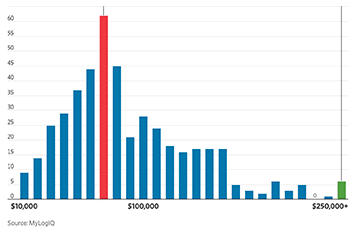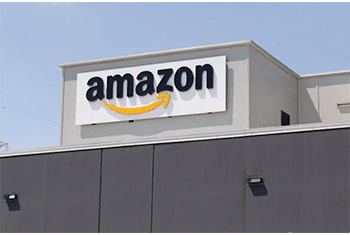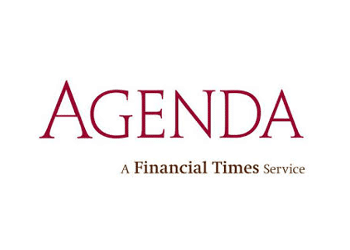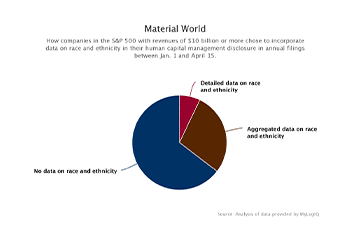While the Covid-19 pandemic disrupted millions of jobs and most businesses, many workers kept their jobs and their salaries — and some saw pay rise. Median pay changed by 5% or less either way at about a third of S&P 500 companies. It rose by more than 5% at 184 companies, and fell by more than 5% at… Continue reading From Amazon to Starbucks, What Companies Paid Workers in the Pandemic
Tag: Human Capital
From Amazon to Starbucks, What Companies Paid Workers in the Pandemic
While the Covid-19 pandemic disrupted millions of jobs and most businesses, many workers kept their jobs and their salaries—and some saw pay rise.
Median pay changed by 5% or less either way at about a third of S&P 500 companies. It rose by more than 5% at 184 companies, and fell by more than 5% at 125.
Those are among the revelations from a Wall Street Journal analysis of annual disclosures by 492 companies using data provided by MyLogIQ. To see the median pay at S&P 500 companies, search or sort the table toward the bottom of this article.
Nearly 140 companies in the S&P 500—including Netflix Inc. and railroad CSX Corp. —said their median worker was paid at least $100,000 last year. Four dozen, including Starbucks Corp. and Amazon.com Inc., said their median worker made less than $30,000 last year. The wages from those four companies were little changed from 2019.
Here’s How Much S&P 500 Companies Paid Workers During the Pandemic
The coronavirus pandemic undoubtedly caused upheaval for millions of workers, with many losing their jobs, while others have seen their work seriously disrupted. Many also, however, saw their roles unscathed by the pandemic, while some even saw pay rises, with a new analysis from The Wall Street Journal highlighting the differences in median pay among S&P 500 companies – the… Continue reading Here’s How Much S&P 500 Companies Paid Workers During the Pandemic
Investors Probe Employee Engagement Data
As boards delve deeper into human capital oversight, employee engagement data is becoming more pertinent to directors and other senior leaders, sources say. Frequent surveys on specific engagement problem areas have replaced long, drawn-out annual employee surveys, and human resources leaders are reporting the findings up to the board as they monitor issues such as corporate culture and employee mental health.
“Employee engagement is front and center for companies right now,” says Rebecca Ray, executive vice president of human capital at The Conference Board. “I think a lot of senior leaders are rightfully concerned about how to preserve the best parts of their culture. As they look at whatever life-changing event might be now thrown at you, there may need to be conversations about what is the best part of our culture, and one of the ways you can gauge that is by having a lot of conversations at the grass root [employee] level.”
Indeed, there were 200 mentions of employee engagement in SEC filings from S&P 500 companies between April 30, 2020, and April 30, 2021, according to data provided to Agenda from public company intelligence provider MyLogIQ.
Scant Diversity Data in Human Capital Disclosures
Mentions of diversity are featuring prominently in companies’ human capital disclosures this proxy season; however, most companies are staying mum on the numbers. An analysis of 10-Ks filed by big companies by mid-April shows that only about a third disclosed any workplace demographic data on race and ethnicity. Fewer still broke the data out into specific demographic groups.
The new human capital management disclosure requirement was introduced by the Securities and Exchange Commission for the 2021 proxy season and requires companies to disclose material factors related to the management of the workforce. However, the SEC provided little guidance on what exactly companies should disclose, leaving it up to them to determine what would be material to investors.
Thus, the type of information disclosed so far varies widely. Some commonly included fields were global head count, regional representation of employees, employment contract type, collective bargaining agreements, staff turnover, components of employee compensation and wellness initiatives, among others.
…But only 35% of the companies disclosed data on racial and ethnic demographics according to an analysis of data from public company intelligence provider MyLogIQ.
California Grocery Chain Says Hero Pay Is Forcing Them To Close Stores
CNN’s Kyung Lah takes a closer look at grocery store chains in California that say they have to close after being forced to give “hero pay” wages to employees.
Asian-American Professionals Push For Visibility at Work
Kaycee Lai spent years in Silicon Valley trying to avoid calling attention to his ethnic identity.
Early in his career, if he left work to get bubble tea, a Taiwanese drink, he’d tell his white colleagues he was getting coffee. When co-workers made comments about his race—such as suggesting that, as an Asian male, he should be in coding rather than sales—he would laugh them off.
“For the longest time, Asian-Americans have felt like you can achieve the American dream so long as you shut up and aren’t seen,” says Mr. Lai, who worked at Microsoft and software company VMware before founding his own data-analytics firm, Promethium, in 2018.
But amid a wave of outrage and sorrow prompted by a recent surge in verbal and physical attacks against people of Asian descent, that sentiment is changing among many Asian-American professionals. Since the Atlanta shooting last month in which six women of Asian descent were among eight killed, many Asian professionals have talked at company town halls about their experiences of racism and what it means to be Asian in U.S. workplaces and society. Some have pushed for donations from their employers toward issues facing Asian communities, while others have simply called for Asians to be more visible in the workplace.
…Among CEOs of S&P 500 companies, 3% are Indian and 2% are of other Asian descent, according to MyLogIQ, a data tracker.
McDonald’s CEO Made 1,100 Times What His Workers Did
The U.S. Securities and Exchange Commission (SEC) has long required public corporations to disclose the compensation of their top officers. The debate about whether chief executive officers are paid too much has gone on for decades. Many investors object to high CEO pay, which often runs into the tens of millions of dollars. Boards of directors claim that good CEOs are hard to find and that they have responsibilities for tens of thousands or even hundreds of thousands of workers.
Last year, the CEO of McDonald’s, Christopher Kempczinski, made 1,189 times the median compensation of his workers, according to an exclusive analysis of the pay of 294 public company CEOs done by MyLogIQ, which uses artificial intelligence (AI) and machine learning to examine SEC data. His total pay was $10,847,032 in 2020. The company’s proxy stated, “McDonald’s is committed to a strong pay-for-performance culture that closely aligns the interests of executives with those of shareholders.”







